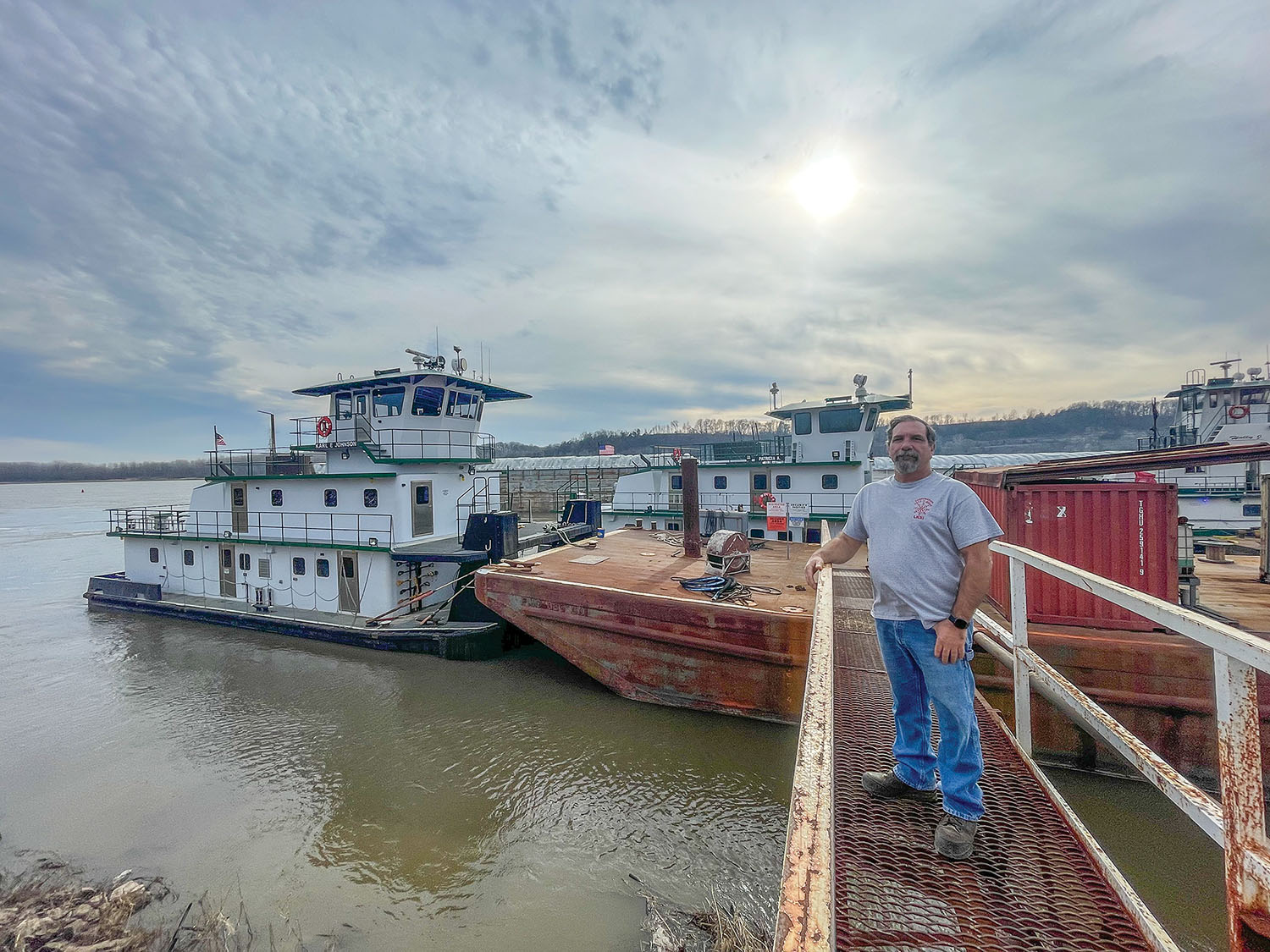Captain Robert Kisro began his river journey in 1988, when he was hired as a deckhand for Mid-America Transportation. Kisro hails from Evansville, Ill., a town in southern Illinois with a total population of 802 people in agricultural Randolph County, located right on the Kaskaskia River. The Kaskaskia flows 325 miles from its pooled headwaters at Lake Carlyle in central Illinois downstate until it joins with the Mississippi River just south of Ste. Genevieve Mo., and north of Chester, Ill.
A friend of Kisro’s who worked for Mid-America had gotten him intrigued by the river life. “I had worked on farms since I was 12,” Kisro said. “My friend who hired me said farm hands made the best deckhands. Now I hire people, and I still think that’s true. Farm hands know how to work.”
Mid-America was sold to Mid-South in 1990. During his employment at Mid-America and then Mid-South, Kisro worked three weeks on and three weeks off. He was promoted to second mate after the buyout. During his employment at Mid-South, Kisro would go to the wheelhouse and steer the boat when he was off watch. In May 1993, on his own, Kisro attended the River School in Memphis, Tenn., and he earned his pilot’s license. In July 1993, he accepted a pilot position with Southern Illinois Transfer Company.
Kisro spent his career as a pilot and master on the Kaskaskia and mid-Mississippi rivers. Barge loads on the Kaskaskia include scrubber stone for the nearby Prairie State clean coal plant, as well as grain, coiled steel, synthetic gypsum and fly ash. Sometimes SITCO boats would be called upon to corral grounded or loose barges on the Mid-Mississippi for other towing companies. “We did a lot of rounding up of grounded or loose barges in the 1990s,” Kisro remembers. He recalled one occasion when he found a grounded barge behind Liberty Island, separated from Randoph County by a narrow inlet. Kisro tried to back out with the barge the way he came in. “The current had other ideas, though,” causing his deckhand a few nervous moments.
Other nervous moments occurred during the flood of 1993. Kisro said, “We were hired to try and save farmers’ levees in Ste. Genevieve, Mo. We were told to get barges of rock to the levee any way possible, and the only way to do it was drive through the trees, so we did. We were knocking down huge trees with boats and barges. The boats were grinding up the trees with the wheel. Tree limbs were all over the boats and barges. We also had limbs sticking out of the windows of the boats. Snakes were falling out of the trees onto the boats and barges. I do not like snakes, but we got the job done.” Kisro has also moved the dredge America numerous times around the mid-Mississippi from one location to another.
Kisro became port captain for Southern Illinois Transfer in 2007., He oversees the day-to-day operations of nine boats, 44 employees and five loading and unloading facilities while trying to keep his hand in with occasional trips behind the sticks. “Southern Illinois Transfer would not be the company that it is today if not for the experienced and hard-working crews that go above and beyond every day to make sure the job is done,” he said.
SITCO’s headquarters office is in Sparta, Ill., the town that stood in for Sparta, Miss., in the groundbreaking 1967 film In the Heat of the Night starring Sidney Poitier, about a black Philadelphia cop who has to work with a Southern sheriff to solve a murder.
Thanks in great part to the efforts of the members of the Lower Kaskaskia Stakeholders Inc. over many years, the region around the Kaskaskia River is prosperous and growing today. The most recent boat built for SITCO was the Robert S. Wilkins, named for the former Corps of Engineers employee and early LKSI activist whom SITCO CEO and co-owner Kurt Johnson described as a “legend” at the christening last September (WJ, September 23, 2023).
Kisro was the first captain to command the boats pushing the barge used for LKSI’s annual barge trip, which The Waterways Journal has covered over the years. Kisro performed that duty for many years with boats including the Lisa Ann, Dale W and Kaskaskia Warrior.
“The Kaskaskia is a smaller river, and not everyone used to the Mississippi prefers it.” Kisro said. “I know Mississippi River pilots and captains who don’t like it. They are used to working with that Mississippi River current to help them position barges when making up tows. On a river like the Kaskaskia, you’ve got to use all your horsepower to make the barges do what you want them to do. When you kick up the water in maneuvering, it makes the boat behave differently. It’s just a different way of operating, and not everyone’s used to it.”
The Kaskaskia is also chock-full of Asian carp. Kisro remembers that “the boat was often full of carp” after a shift. Recent harvesting and culling efforts have reduced the carp population somewhat. They can still be seen jumping energetically on the LSKI barge trips, but it no longer looks like the river’s surface is boiling, he said.
Part of Kisro’s current job includes mentoring steersmen in SITCO’s steersman program, for which he is the designated examiner. “All of the pilots we have now, we grew up ourselves,” he says. SITCO is growing and currently advertising for deckhands.
Outside his work, Kisro keeps busy with his three children—one daughter and two sons, plus eight grandchildren—going to ball games and school functions. Kisro was the first member of his family to work on the rivers. His youngest son, Brendan, age 36, followed him into the river industry upon graduating from high school, starting out as a deckhand. He now serves ashore, operating a crane for Southern Illinois Transfer Company at Kaskaskia River Regional Port District 2 at Red Bud, Ill., on Kaskaskia River Mile 19 .
Of his long career on the river, from deckhand to mate to pilot to port captain, Kisro said, “While life on the river is not for everyone, I’ve always loved it and wouldn’t change a thing.”




